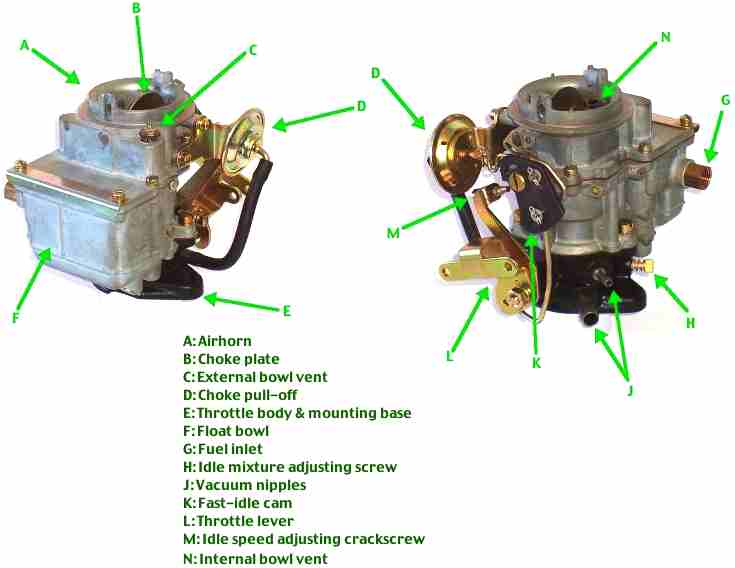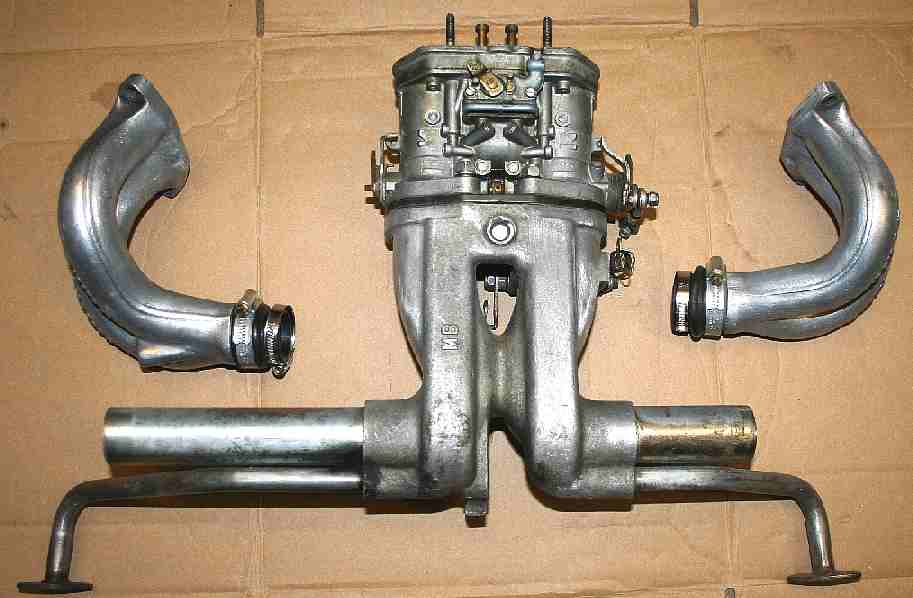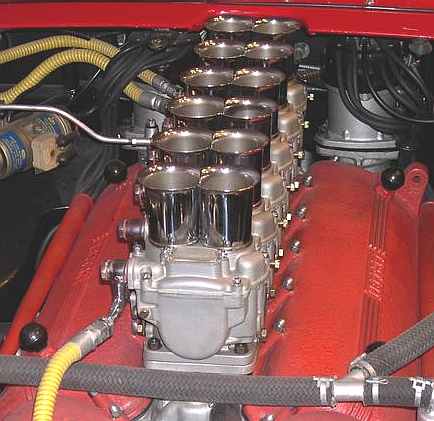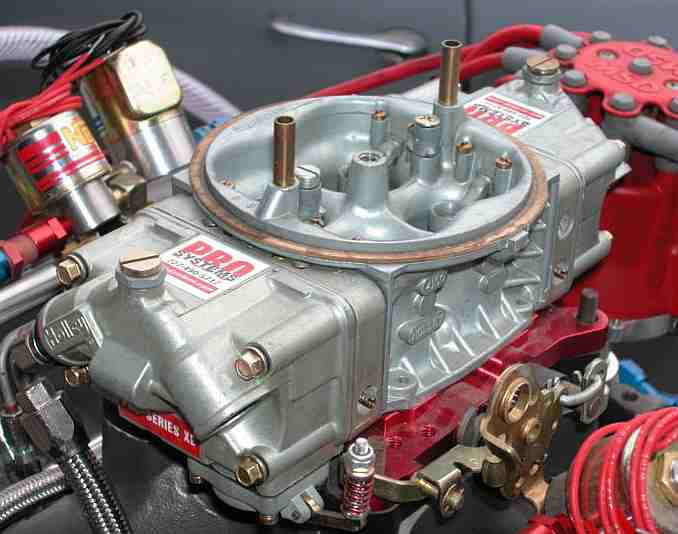|
CARBURETTOR
|
||||
|
HOME | INDEX | AUTOMOTIVE | BLUEPLANET | ELECTRIC CARS | E. CYCLES | NEWS | SOLAR CARS |
||||
|
The carburetor, carburettor, or carburetter, also called carb (in North America) or carby (chiefly in Australia) for short, is a device that blends air and fuel for an internal combustion engine. It was invented by Hungarian scientists Donát Bánki and János Csonka in 1893.
Carburettor parts
Carburetors were the usual fuel delivery method for almost all engines up until the mid-1980s, when fuel injection became the preferred method of automotive fuel delivery. A majority of motorcycles still utilize carburetors due to lower cost, but as of 2005, many new models are now being introduced with fuel injection. Carburetors are still found in small engines and in older or specialized automobiles, such as those designed for stock car racing.
When carburetors are used in small aircraft with piston engines, modifications such as the Bendix carburetter are needed to avoid fuel starvation under high g-forces.
Most carbureted (as opposed to fuel-injected) engines have a single carburetor, though some engines use multiple carburetors. Older engines used updraft carburetors, where the air enters from below the carburetor and exits through the top. This had the advantage of never "flooding" the engine, as any liquid fuel droplets would fall out of the carburetor instead of into the intake manifold; it also lent itself to use of an oil bath air cleaner, where a pool of oil below a mesh element below the carburetor is sucked up into the mesh and the air is drawn through the oil covered mesh; this was an effective system in a time when paper air filters did not exist. Beginning in the late 1930s, downdraft carburetors were the most popular type for automotive use in the United States. In Europe, the sidedraft carburettors replaced downdraft as free space in the engine bay decreased and the use of the SU-type carburetor (and similar units from other manufacturers) increased. Some small propeller-driven aircraft engines still use the updraft carburetor design, however many use more modern designs such as the Constant Velocity (CV) Bing(TM) carburetor.
The carburetor works on Bernoulli's principle: the faster air moves, the lower its pressure. The throttle (accelerator) linkage does not directly control the flow of liquid fuel. Instead, it actuates carburettor mechanisms which meter the flow of air being sucked into the engine. The speed of this flow, and therefore its pressure, determines the amount of fuel drawn into the airstream.
Operation
Carburetors are either:
Under all engine operating conditions, the carburetor must:
This job would be simple if air and gasoline (petrol) were ideal fluids; in practice, however, their deviations from ideal behavior due to viscosity, fluid drag, inertia, etc. require a great deal of complexity to compensate for exceptionally high or low engine speeds. A carburetor must provide the proper fuel/air mixture across a wide range of ambient temperatures, atmospheric pressures, engine speeds and loads, and centrifugal forces:
In addition, modern carburetors are required to do this while maintaining low rates of exhaust emissions.
To function correctly under all these conditions, most carburetors contain a complex set of mechanisms to support several different operating modes, called circuits.
Basics
A carburetor basically consists of an open pipe, a "throat" or "barrel" through which the air passes into the inlet manifold of the engine. The pipe is in the form of a venturi it narrows in section and then widens again, causing the airflow to increase in speed in the narrowest part. Below the venturi is a butterfly valve called the throttle valve — a rotating disc that can be turned end-on to the airflow, so as to hardly restrict the flow at all, or can be rotated so that it (almost) completely blocks the flow of air. This valve controls the flow of air through the carburetor throat and thus the quantity of air/fuel mixture the system will deliver, thereby regulating engine power and speed. The throttle is connected, usually through a cable or a mechanical linkage of rods and joints or rarely by pneumatic link, to the accelerator pedal on a car or the equivalent control on other vehicles or equipment.
Fuel is introduced into the air stream through small holes at the narrowest part of the venturi. Fuel flow in response to a particular pressure drop in the venturi is adjusted by means of precisely-calibrated orifices, referred to as jets, in the fuel path.
Off-idle circuit
As the throttle is opened up slightly from the fully closed position, the throttle plate uncovers additional fuel delivery holes behind the throttle plate where there is a low pressure area created by the throttle plate blocking air flow; these allow more fuel to flow as well as compensating for the reduced vacuum that occurs when the throttle is opened, thus smoothing the transition to metering fuel flow through the regular open throttle circuit.
Main open-throttle circuit
As the throttle is progressively opened, the manifold vacuum is lessened since there is less restriction on the airflow, reducing the flow through the idle and off-idle circuits. This is where the venturi shape of the carburetor throat comes into play, due to Bernoulli's principle (i.e., as the velocity increases, pressure falls). The venturi raises the air velocity, and this high speed and thus low pressure sucks fuel into the airstream through a nozzle or nozzles located in the center of the venturi. Sometimes one or more additional booster venturis are placed coaxially within the primary venturi to increase the effect.
As the throttle is closed, the airflow through the venturi drops until the lowered pressure is insufficient to maintain this fuel flow, and the idle circuit takes over again, as described above.
Bernoulli's principle, which is caused by the momentum of the fluid, is a dominant effect for large openings and large flow rates, but since fluid flow at small scales and low speeds (low Reynolds number) is dominated by viscosity, Bernoulli's principle is ineffective at idle or slow running and in the very small carburetters of the smallest model engines. Small model engines have flow restrictions ahead of the jets to reduce the pressure enough to suck the fuel into the air flow. Similarly the idle and slow running jets of large carburettors are placed after the throttle valve where the pressure is reduced partly by viscous drag, rather than by Bernoulli's principle. The most common rich mixture device for starting cold engines was the choke, which works on the same principle.
Power valve
For open throttle operation a richer mixture will produce more power, prevent detonation, and keep the engine cooler. This is usually addressed with a spring-loaded "power valve", which is held shut by engine vacuum. As the throttle opens up, the vacuum decreases and the spring opens the valve to let more fuel into the main circuit. On two-stroke engines, the operation of the power valve is the reverse of normal - it is normally "on" and at a set rpm it is turned "off". It is activated at high rpm to extend the engine's rev range, capitalizing on a two-stroke's tendency to rev higher momentarily when the mixture is lean.
Twin choke Webber carburettor kit for VW aircooled engine - Nice!
Accelerator pump
The greater inertia of liquid gasoline, compared to air, means that if the throttle is suddenly opened, the airflow will increase more rapidly than the fuel flow, causing a temporary "lean" condition which causes the engine to "stumble" under acceleration (the opposite of what is normally intended when the throttle is opened). This is remedied by the use of a small mechanical pump, usually either a plunger or diaphragm type actuated by the throttle linkage, which propels a small amount of gasoline through a jet, wherefrom it is injected into the carburetor throat. This extra shot of fuel counteracts the transient lean condition on throttle tip-in. Most accelerator pumps are adjustable for volume and/or duration by some means. Eventually the seals around the moving parts of the pump wear such that pump output is reduced; this reduction of the accelerator pump shot causes stumbling under acceleration until the seals on the pump are renewed.
The accelerator pump is also used to prime the engine with fuel prior to a cold start. Excessive priming, like an improperly-adjusted choke, can cause flooding. This is when too much fuel and not enough air are present to support combustion. For this reason, carburetors are equipped with an unloader mechanism: The accelerator is held to the full extent of its travel while the engine is cranked, the unloader holds the choke open and admits extra air, and eventually the excess fuel is cleared out and the engine starts.
Choke
When the engine is cold, fuel vaporizes less readily and tends to condense on the walls of the intake manifold, starving the cylinders of fuel and making the engine difficult to start; thus, a richer mixture (more fuel to air) is required to start and run the engine until it warms up. A richer mixture is also easier to ignite.
To provide the extra fuel, a choke is typically used; this is a device that restricts the flow of air at the entrance to the carburetor, before the venturi. With this restriction in place, extra vacuum is developed in the carburetor barrel, which pulls extra fuel through the main metering system to supplement the fuel being pulled from the idle and off-idle circuits. This provides the rich mixture required to sustain operation at low engine temperatures.
In addition, the choke is connected to a "fast idle cam" or other such device which prevents the throttle from closing fully, which could starve the venturis of vacuum and cause the engine to stall. This also serves as a way to help the engine warm up quickly by idling it at a higher than normal speed. In addition, it increases airflow throughout the intake system which helps to better atomize the cold fuel and smooth out the idle.
In older carbureted cars, the choke was controlled by a cable connected to a pull-knob on the dashboard operated by the driver. In most carbureted cars produced from the mid 1960s onward (mid 1950s in the United States) it is usually automatically controlled by a thermostat employing a bimetallic spring, which is exposed to engine heat. This heat may be transferred to the choke thermostat via simple convection, via engine coolant, or via air heated by the exhaust. More recent designs use the engine heat only indirectly: A sensor detects engine heat and varies electrical current to a small heating element, which acts upon the bimetallic spring to control its tension, thereby controlling the choke. A choke unloader is a linkage arrangement that forces the choke open against its spring when the vehicle's accelerator is moved to the end of its travel. This provision allows a "flooded" engine to be cleared out so that it will start.
Some carburetors do not have a choke but instead use a mixture enrichment circuit, or enrichener. Typically used on small engines, notably motorcycles, enricheners work by opening a secondary fuel circuit below the throttle valves. This circuit works exactly like the idle circuit, and when engaged it simply supplies extra fuel when the throttle is closed.
Classic British motorcycles, with side-draft slide throttle carburetors, used another type of "cold start device", called a "tickler". This is simply a spring-loaded rod that, when depressed, manually pushes the float down and allows excess fuel to fill the float bowl and flood the intake tract. If the "tickler" was held down too long it also flooded the outside of the carburetor and the crankcase below, and was therefore a fire hazard.
Other elements
The interactions between each circuit may also be affected by various mechanical or air pressure connections and also by temperature sensitive and electrical components. These are introduced for reasons such as response, fuel efficiency or automobile emissions control. Various air bleeds (often chosen from a precisely calibrated range, similarly to the jets) allow air into various portions of the fuel passages to enhance fuel delivery and vaporization. Extra refinements may be included in the carburetor/manifold combination, such as some form of heating to aid fuel vaporization.
Fuel supply
Float chamber
To ensure a ready mixture, the carburetor has a "float chamber" (or "bowl") that contains a quantity of fuel at near-atmospheric pressure, ready for use. This reservoir is constantly replenished with fuel supplied by a fuel pump. The correct fuel level in the bowl is maintained by means of a float controlling an inlet valve, in a manner very similar to that employed in toilet tanks. As fuel is used up, the float drops, opening the inlet valve and admitting fuel. As the fuel level rises, the float rises and closes the inlet valve. The level of fuel maintained in the float bowl can usually be adjusted, whether by a setscrew or by something crude such as bending the arm to which the float is connected. This is usually a critical adjustment, and the proper adjustment is indicated by lines scribed into a window on the float bowl, or a measurement of how far the float hangs below the top of the carburetor when disassembled, or similar. Floats can be made of different materials, such as sheet brass soldered into a hollow shape, or of plastic; hollow floats can spring small leaks and plastic floats can eventually become porous and lose their flotation; in either case the float will fail to float, fuel level will be too high, and the engine will not run well unless the float is replaced. The valve itself becomes worn on its sides by its motion in its "seat" and will eventually try to close at an angle, and thus fails to shut off the fuel completely; again, this will cause excessive fuel flow and poor engine operation. Conversely, as the fuel evaporates from the float bowl, it leaves sediment, residue, and varnishes behind, which clog the passages and can interfere with the float operation. This is particularly a problem in automobiles operated for only part of the year and left to stand with full float chambers for months at a time; commercial fuel stabilizer additives are available that reduce this problem.
Usually, special vent tubes allow air to escape from the chamber as it fills or enter as it empties, maintaining atmospheric pressure within the float chamber; these usually extend into the carburetor throat. Placement of these vent tubes can be somewhat critical to prevent fuel from sloshing out of them into the carburetor, and sometimes they are modified with longer tubing. Note that this leaves the fuel at atmospheric pressure, and therefore it cannot travel into a throat which has been pressurized by a supercharger mounted upstream; in such cases, the entire carburetor must be contained in an airtight pressurized box to operate. This is not necessary in installations where the carburetor is mounted upstream of the supercharger, which is for this reason the more frequent system. However, this results in the supercharger being filled with compressed fuel/air mixture, with a strong tendency to explode should the engine backfire; this type of explosion is frequently seen in drag races, which for safety reasons now incorporate pressure releasing blow-off plates on the intake manifold, breakaway bolts holding the supercharger to the manifold, and shrapnel-catching ballistic nylon blankets surrounding the superchargers.
If the engine must be operated in any orientation (for example a chain saw), a float chamber cannot work. Instead, a diaphragm chamber is used. A flexible diaphragm forms one side of the fuel chamber and is arranged so that as fuel is drawn out into the engine the diaphragm is forced inward by ambient air pressure. The diaphragm is connected to the needle valve and as it moves inward it opens the needle valve to admit more fuel, thus replenishing the fuel as it is consumed. As fuel is replenished the diaphragm moves out due to fuel pressure and a small spring, closing the needle valve. A balanced state is reached which creates a steady fuel reservoir level, which remains constant in any orientation.
Colombo Type 125 "Testa Rossa" engine in a 1961 Ferrari 250TR Spyder with six Weber two-barrel carburetors intaking air through 12 "trumpets" visible on top of the engine, one individually adjustable barrel for each cylinder; the ultimate in tunability
Multiple carburetor barrels
While low performance carburetors may have only one barrel, most carburetors have more than one venturi, or "barrel", most commonly a two barrel, with four barrels being common in higher performance larger displacement engines, to accommodate the higher air flow rate with larger engine displacement. Multi-barrel carburetors can have non-identical primary and secondary barrel(s) of different sizes and calibrated to deliver different air/fuel mixtures; they can be actuated by the linkage or by engine vacuum in "progressive" fashion, so that the secondary barrels do not begin to open until the primaries are almost completely open. This is a desirable characteristic which maximizes airflow through the primary barrel(s) at most engine speeds, thereby maximizing the pressure "signal" from the venturis, but reduces the restriction in airflow at high speeds by adding cross-sectional area for greater airflow. These advantages may not be important in high-performance applications where part throttle operation is irrelevant, and the primaries and secondaries may all open at once, for simplicity and reliability; also, V configuration engines, with two cylinder banks fed by a single carburetor, may be configured with two identical barrels, each supplying one cylinder bank. In the widely seen V8 and 4-barrel carburetor combination, there are often two primary and two secondary barrels.
Multiple carburetors can be mounted on a single engine, often with progressive linkages; four two-barrel carburetors were frequently seen on high performance American V8s, and multiple four barrel carburetors are often now seen on very high performance engines.
Carburetor adjustment
Too much fuel in the fuel-air mixture is referred to as too rich, and not enough fuel is too lean. The mixture is normally adjusted by one or more needle valves on an automotive carburetor, or a pilot-operated lever on piston-engined aircraft (since mixture is air density (altitude) dependent). The (stoichiometric) air to gasoline ratio is 14.7:1, meaning that for each weight unit of gasoline, 14.7 units of air will be consumed. Stoichiometric mixture are different for various fuels other than gasoline.
Ways to check carburetor mixture adjustment include: measuring the carbon monoxide, hydrocarbon, and oxygen content of the exhaust using a gas analyzer, or directly viewing the colour of the flame in the combustion chamber through a special glass-bodied spark plug sold under the name "Colortune" for this purpose. The flame colour of stoichiometric burning is described as a "bunsen blue", turning to yellow if the mixture is rich and whitish-blue if too lean.
The mixture can also be judged after engine running by the state and color of the spark plugs: black, dry sooty plugs indicate a too rich mixture, white to light gray deposits on the plugs indicate a lean mixture. The correct color should be a brownish gray. See also reading spark plugs.
In the early 1980s, many American-market vehicles used special "feedback" carburetors that could change the base mixture in response to signals from an exhaust gas Oxygen sensor. These were mainly used to save costs (since they worked well enough to meet 1980s emissions requirements and were based on existing carburetor designs), but eventually disappeared as falling hardware prices and tighter emissions standards made fuel injection a standard item.
Where multiple carburetors are used the mechanical linkage of their throttles must additionally be adjusted to synchronism for smooth engine running.
History and development
The carburetor was invented by the Hungarian engineer Donát Bánki in 1893. Frederick William Lanchester of Birmingham, England experimented early on with the wick carburetor in cars. In 1896 Frederick and his brother built the first petrol driven car in England, a single cylinder 5 hp (4 kW) internal combustion engine with chain drive. Unhappy with the performance and power, they re-built the engine the next year into a two cylinder horizontally opposed version using his new wick carburetor design. This version completed a 1,000 mile (1600 km) tour in 1900 successfully incorporating the carburetor as an important step forward in automotive engineering.
The word carburetor comes from the French carbure, meaning 'carbide' [1]. To carburete means to combine with carbon. In fuel chemistry, the term has the more specific meaning of increasing the carbon (and therefore energy) content of a fuel by mixing it with a volatile hydrocarbon.
Catalytic carburetors
A catalytic carburetor mixes fuel fumes with water and air in the presence of heated catalysts such as nickel or platinum. This breaks the fuel down into methane, alcohols, and other lighter-weight fuels. The original catalytic carburetor was introduced to permit farmers to run tractors from modified and enriched kerosene. The U.S. Army also used catalytic carburetors with great success in World War II, in the North African desert campaign.
While catalytic carburetors were made commercially available in the early 1930s, two major factors limited their widespread public use. First, the addition of additives to commercial gasoline made it unsuitable for use in engines with catalytic carburetors. Tetra-ethyl lead was introduced in 1932 to raise gasoline's resistance to engine knock, thereby permitting the use of higher compression ratios). Second, the economic advantage of using kerosene over gasoline faded in the 1930s, eliminating the catalytic carburetor's primary advantage.
A high performance 4-barrel carburetor
Manufacturers
LINKS and REFERENCE
The Fish Carburetor: http://www.fireballroberts.com/Fish_Patents.htm Dual Fuel Unit in 1975 Chevy Suburban runs on gasoline and alcohol: http://www.mikebrownsolutions.com/dual1.htm http://www.mikebrownsolutions.com/dual2.htm http://www.mikebrownsolutions.com/dual3.htm http://www.mikebrownsolutions.com/dual4.htm http://www.mikebrownsolutions.com/dual5.htm
Patents
The A - Z of CARS and MOTORCYCLES
Please click on the links above to find out about these famous automotive makers. If your company is not included and you would like to be listed, please let us know.
A taste for adventure capitalists
Solar Cola - a healthier alternative
|
||||
|
The
content of this website is copyright © and design copyright 1991 and
2012 Electrick Publications and NJK. All rights reserved. The bird |
||||
|
EDUCATION | SOLAR CAR RACING TEAMS | SOLAR CAR RACING EVENTS | FILMS | MUSIC |



